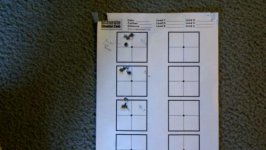Joe, the above post by classcat is an example of the sort of information found all over the 'net, and I COMPLETELY disagree with it. I MUST disagree because this is BRC, not the Rollicking Arounde Ye Jollie Kemmpfire Forum.
point #1-
JOE:Neck tension is a major factor in accuarcy. I completely disagree. My experience has been that neck tension 'may' be worth a tenth inch of vertical, it's a fine-tuning issue at absolute best.
point #2-
Before cutting you must expand the neck on all brass using an expander mandrel and when cutting a mandrel for cutting;usually.00005 smaller. I completely disagree. come on!!......00005??? this is a completely goofy number, meaningless. In actual fact the brass necks and the turning mandrel vary more than this by a factor of 100! When I turn necks I use a clearance of "under a thou" and keep the mandrel in a pot of room temp water between uses.
point #3-
Average neck sizes of federal,lapua,or rem. is high of .0016 to low of .0013. Take the low "VARRIES" and cut to .0012 this will insure the neck has been cut evenly. I completely disagree. Brass with a fat side will actually shoot BETTER because SOME of the bullets will start straighter into the bore because of the fat side. Pure dee LUCK, but some will. Cutting all the highs off to make the necks universally skinny only INSURES that each and every bullet will start down the bore with that excess inbore yaw built in.
point #4-
NECK SIZE "BUTTON" formula is >0012+.0012 +.308= .332. this is the size of a round without neck tension If you want to hold .0003 you need a .329 button. I completely disagree. First of all going for 3 tenths is goofy-speak! I'll assume class actually meant to say .003 or three thousandth's, dangerous assumption but I'll make it because 3 thou is kindofa roundoff "best one I like" number amongst the masses.... and he does say .329 button. And as to the "formula"...While the math looks OK (numbers don't lie and the addition is perty simple

) It's not only useless for accuracy, it doesn't account for springback. In real life you must use a bushing 4 to 4.5 thou under to achieve .003 interference because the brass springs back a thou or thou-and-a-half. Do you NEED three thou? Dunno, only the gun can tell you that but meantime using three thou interference almost guarantees loaded round concentricity issues. You CANNOT size a neck down 4 thou and then cram a bullet into .003 under and get straight reloads. It just ain't gonna' happen. (not that it MATTERS, it just ain't gonna' happen!)
point #5-
If you have custom chambers that neck size should have been engraved on the barrel,or if they are factory follow S.A.M.I. I completely disagree. First of all, about 99.9% of "custom chambers" are done between centers which means that the number engraved on the barrel may be off as much as a thou. Don't count on it! (especially when we're talking about MILLIONTH'S like class here) and as far as "factory follow S.A.M.I." (BTW it's SAAMI) you must realize that SAAMI isn't a "dimension" it's a set of allowable parameters. These parameters vary hugely. AND, they're useless.
Read this one line at least, print it out and post it on your friggin' wall....THE ONLY DIMENSION THAT MATTERS IS THE CLEARANCE BETWEEN THE LOADED NECK AND THE NECK OF THE CHAMBER!!!!! Because this dimension tells you how much in-bore cant or yaw will exist. THIS DIMENSION .... THIS clearance determines how much the base of the bullet WILL be kicked oper when the 600lb hammer drops.
point #6-
You will see a major change once you fully understand and use the process. I completely disagree. You will not see a MAJOR change of any sort, but any change you do see will be to the BAD re accuracy.
point#7-
Also the bullet must be seated in concentricity,if the bullet is not straight it will not go straight. I completely disagree. Making straight reloads does NOTHING to approach the problem of sloppy fit. And sloppy FIT is the root of the problem, not "alignment." If you really want to increase accuracy using sloppy necked chambers try making cases from something much larger. Like .308 from 30-06 cases. Then you can actually decrease neck clearance.
I could go on for days.......... but I won't.
Meantime, ALLA' you'se guys who don't KNOW this stuff please go out and try it!!!
Take accurate notes.
NUMBER ONE....
take friggin' NOTES people!!!
Take ALL rounds fired into account.
NUMBER TWO....
count EVERY friggin' shot people!!! Don't get led down the rosy path of "take out that one flier" and "all day if I do my part" and "I musta' had a bad day."
And be honest.
NUMBER THREE.....
Be friggin' HONEST with yourself!!! If it isn't repeatable it's an abberation! "What the gun does" is what it DOES, every day all day. Most of the advice out there is un-verifiable crap opinion getting passed on thru the ages. (and there area a TON of these old wive's tales in the reloading arena) Try this stuff and shoot aggregate groups. A single group is completely useless. Shoot 5 groups of 5 shots to see what the rifle did one time...
opinionsby
al


